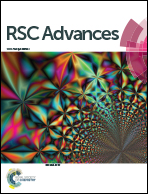Detecting hypoxia in vitro using 18F-pretargeted IEDDA “click” chemistry in live cells†
Abstract
We have exemplified a pretargeted approach to interrogate hypoxia in live cells using radioactive bioorthogonal inverse electron demand Diels–Alder (IEDDA) “click” chemistry. Our novel 18F-tetrazine probe ([18F]FB-Tz) and 2-nitroimidazole-based TCO targeting molecule (8) showed statistically significant (P < 0.0001) uptake in hypoxic cells (ca. 90 %ID per mg) vs. normoxic cells (<10 %ID per mg) in a 60 min incubation of [18F]FB-Tz. This is the first time that an intracellularly targeted small-molecule for IEDDA “click” has been used in conjunction with a radioactive reporter molecule in live cells and may be a useful tool with far-reaching applicability for a variety of applications.



 Please wait while we load your content...
Please wait while we load your content...